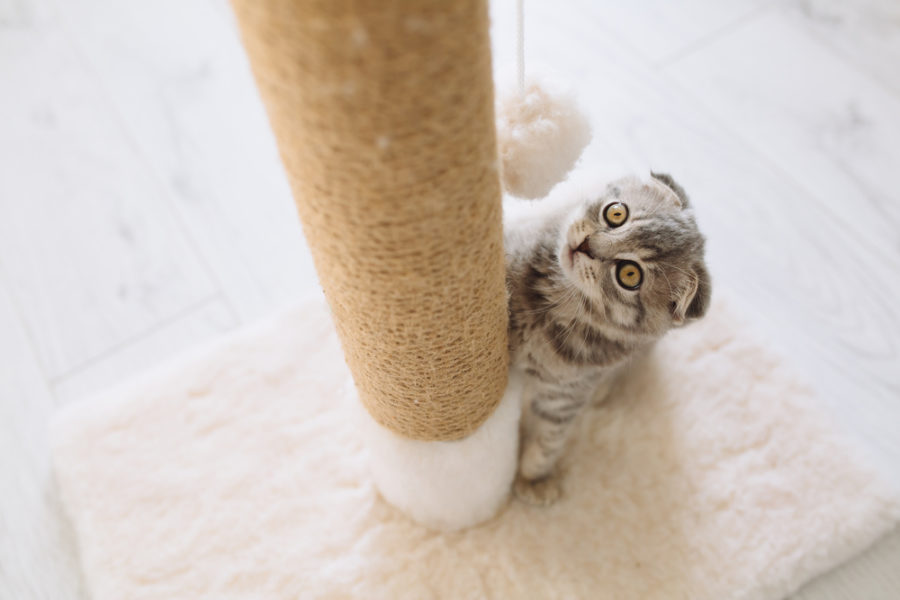“I can’t keep my cat from scratching the furniture,” one of my friends complained to me the other day. “My sofa’s in shreds. Do you know how I can get her to stop?” The answer is simple: scratching posts.
Like a lot of people, my friend is under the impression that scratching is a behavioral problem that needs to be corrected. Actually, cats have a natural, inborn need to scratch. It’s a healthy activity that keeps their claws in good condition and helps to stretch, exercise and relax the muscles in their legs and bodies. It also serves as a marking behavior; glands in the cat’s paw pads leave behind a scent that essentially says “I was here” to other cats.
The bottom line is you won’t be able to stop your cat from scratching, nor should you wish to. If a cat isn’t allowed to scratch as much as she needs to, her muscles will get soft and lose their feline suppleness. The same applies to cats that have been declawed; this inhumane practice not only causes the animal a lot of pain, but also deprives her of one of her main ways of keeping fit.
The solution is to train your cat to scratch only where it’s appropriate. That means investing in a good quality scratching post or tree. The key word here is “quality” – in order for the cat to use the post and leave your upholstery alone, it needs to adequately meet her requirements. Here’s what to look for:
• Make sure the post is sturdily built from solid materials and won’t wobble or tip over when the cat uses it. Look for a product with a good base that will stand up to being leapt on and kicked as well as scratched.
• Choose a post that’s taller than the full length of your cat. Cats like to stretch while they’re scratching. A height of 2½’ to 3’ is ideal. You can also get horizontal scratching posts; again, they should be long enough for the cat to stretch out on.
• If your cat has been targeting your furniture, situate the post nearby so she’ll gravitate to it instead of your favorite armchair. Other excellent locations are near a sunny window or by her favorite sleeping spot; cats often love to have a good scratch after waking.
• Many scratching posts and trees are covered with carpeting. These work very well, but can encourage some cats to start scratching rugs and broadloom as well. If this is an issue for you, choose a product that is either plain wood or covered with sisal rope. You can also get inexpensive scratchers made from corrugated cardboard.
• Consider buying more than one scratching post, especially if you have several cats. Choose a variety of different surfaces and angles to help keep your felines interested.
• If your cat gets bored easily, consider a cat tree or condo. These tall, multi-leveled products often feature various platforms and perches, hiding spots, tunnels, hammocks, and other features that will provide your cat with loads of entertainment and places to snooze or hang out. Again, make sure the tree is sturdy and not easily knocked over.
• Replace or re-cover the post or tree when the surface gets shredded or worn out.
What if she won’t use it?
Occasionally, a cat may need some encouragement to start using a new scratching post. Try rubbing some dried catnip on the surface, or give her a treat every time she uses it. You can also try attaching a toy to the scratching post.
If your kitty still digs at the furniture, try a firm “no” when you catch her in the act, and carry her to the scratching post. Covering your furniture with loosely-fitting slip covers may also help discourage scratching because the cat can’t get a satisfactory hold on the fabric.
Other strategies include keeping your feline’s nails trimmed so they won’t do as much damage to upholstery. You can clip your cat’s nails much the same way you would a dog’s, although you will have to gently press her paw to get her to unsheathe them first. You’ll need a small pair of clippers made especially for cats. Dog clippers are too large and can painfully twist the cat’s toe. Be careful, and make sure you don’t cut into the quick. If in doubt, or if your cat doesn’t like having her feet handled, ask your vet or groomer for help. If all else fails, consider plastic nail sheaths that slip painlessly over the cat’s claws to prevent damage.
Build your own
Many people opt to create their own scratching posts. The simplest of all is a log or large branch with or without bark (be sure you’ve removed any insect pests first). We had a cedar log in our laundry room for years, fastened securely to a support post. The cats used it so much they eventually pulled most of the bark off! Keep in mind that this method can be messy, since the bark will shed every time the cat uses the post, so you may want to strip the log first.
You can also build a scratching post using just a few simple materials:
- 1 – 16”x16” piece of solid wood for the base
- 1 – 2 ½’ or 3’ two-by-four for the upright
- long screws
- sisal rope
Firmly screw the two-by-four onto the base. Wrap the two-by-four tightly with sisal rope and secure the ends with screws. If your cat prefers a less vertical surface, as ours do, you can cut two two-by-fours so they meet at the top in an A-shape – you may need a slightly larger base depending on the angle you choose. Secure with screws and wrap with sisal. If you wish, you can also cover the scratching post (and the base) with spare pieces of carpeting.
Scratching is not just excellent physical exercise for your kitty. It also makes her feel good, just as having a stretch makes us feel relaxed and energized. By providing your feline friend with one or more scratching posts, you’ll be doing her health and happiness a big favor.







